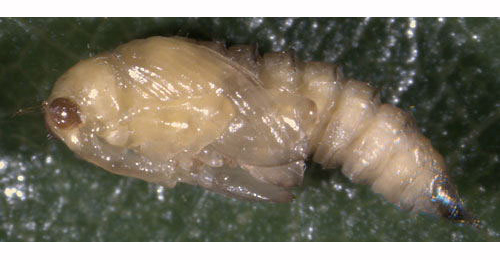|
||||||
|
Orchestes
testaceus (Müller, 1766) Curculio
testaceus Müller,
1766 |
||||||||||||||||||||||||||||||||||||||||||||||
Leaf-miner: Oviposition in the underside of the midrib or a thick lateral vein; later a large scar is visible there. Initially the larva tunnels in the midrib or vein, that inflates and disfigures somewhat as a result. Then the larva starts a corridor in the leaf blade, quite narrow at first, but strongly widening as the larva approaches the leaf margin or leaf tip. The mine is reddish brown in colour. The mature larva makes itself a dark brown globular cocoon in the mine and pupates there. Because the mine is made at a time that the leaf still is unfolding, the leaf becomes permanently rumpled. In the course of the summer the mine erodes away, but the combination of the oviposition scar, the swolllen mibrib and the frayed leave missing a large part of its distal half remains unmistakable (Bladmineerders van Europa, as testaceus including calceatus). The mine is also illustrated in British Leafminers. Larva: The larvae of beetles have a head capsule and chewing mouthparts with opposable mandibles and lack abdominal legs (see examples). Pupa: The pupae of beetles have visible head appendages, wings and legs which lie in sheaths (see examples). The pupa is illustrated in Bladmineerders van Europa.
Comments: Fauna Europaea treats Orchestes calceatus (Germar, 1821) as a junior synonym of Orchestes testaceus (Müller, 1766) following Anderson (1989). According to Morris in Duff (2008) Orchestes calceatus Germar, 1821 on Betula pubescens is distinct from Orchestes testaceus (Müller, 1766) on Alnus in Britain. Hosts in Great Britain and Ireland:
Hosts elsewhere:
Time of year - larvae: July (British leafminers, as testaceus on Betula). Time of year - adults: Currently unknown. Distribution in Great Britain and Ireland: Distribution in Great Britain and Ireland: There are records of Orchestes testaceus including Orchestes calceatus from Bedfordshire, Cambridgeshire, Cheshire, East Kent, East Norfolk, Glamorgan, Hertfordshire, Huntingdonshire, Northamptonshire, Nottinghamshire, Shropshire, West Kent, West Norfolk and West Suffolk (NBN Atlas). Also recorded in Ireland (InvertebrateIreland Online). Distribution elsewhere: There are records of Orchestes testaceus including Orchestes calceatus in continental Europe including Danish mainland, Finland, French mainland, Germany, Italian mainland, Norwegian mainland, Poland, Romania, Russia - Central, East, North, Northwest and South, Sardinia, Slovakia, Sweden, Yugoslavia and in the Nearctic region (Fauna Europaea). NBN Atlas links to known host species: British and Irish Parasitoids in Britain and elsewhere: Currently unknown. |
||||||||||||||||||||||||||||||||||||||||||||||
|
|
|
| External links: | Search the internet: |
|
Biodiversity Heritage Library |
Find
using Google Find using Google Scholar Find images using Google |
| Last updated 08-Jul-2019 Brian Pitkin | ||

